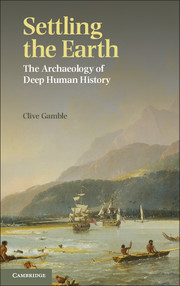Book contents
- Frontmatter
- Dedication
- Contents
- List of boxes
- List of figures
- List of tables
- Acknowledgements
- Glossary
- Web resources for skulls and stone tools
- 1 The worlds of deep human history
- 2 The drivers of climate and environment: Terrae 0–2, 10Ma–50ka
- 3 The recent veneers of climate, environment and population: Terrae 3–5, 50ka to the present day
- 4 Walking and running down the tectonic trail: Terra 0, 10–3.3Ma, and Terra 1, 3.3–1.8Ma
- 5 Three strides across a bio-tidal world: Terra 2, 1.8Ma–50ka
- 6 Going beyond, keeping in touch: Terra 3, 50–4ka
- 7 The call of the north: Terra 3, 50–4ka
- 8 Eyes on the horizon: Terra 4, 4–1ka
- 9 The human reunion in retrospect: Terra 5, after 1400 AD
- Bibliography
- Index
3 - The recent veneers of climate, environment and population: Terrae 3–5, 50ka to the present day
Published online by Cambridge University Press: 05 June 2014
- Frontmatter
- Dedication
- Contents
- List of boxes
- List of figures
- List of tables
- Acknowledgements
- Glossary
- Web resources for skulls and stone tools
- 1 The worlds of deep human history
- 2 The drivers of climate and environment: Terrae 0–2, 10Ma–50ka
- 3 The recent veneers of climate, environment and population: Terrae 3–5, 50ka to the present day
- 4 Walking and running down the tectonic trail: Terra 0, 10–3.3Ma, and Terra 1, 3.3–1.8Ma
- 5 Three strides across a bio-tidal world: Terra 2, 1.8Ma–50ka
- 6 Going beyond, keeping in touch: Terra 3, 50–4ka
- 7 The call of the north: Terra 3, 50–4ka
- 8 Eyes on the horizon: Terra 4, 4–1ka
- 9 The human reunion in retrospect: Terra 5, after 1400 AD
- Bibliography
- Index
Summary
The earth seemed unearthly. We are accustomed to look upon the shackled form of a conquered monster, but there – there you could look at a thing monstrous and free
Joseph Conrad, Heart of Darkness, 1902Holocene Veneers
A constant challenge for archaeologists is to avoid making the past look like the present; in Martin Wobst’s (1978) trenchant phrase, committing ethnography with a shovel. But besides being alert to the issue, there seems little option. In order to animate, rather than merely describe, archaeological evidence, there have to be references to examples of how people act and behave. When it comes to deep history, the reference points have always been those who live by fishing, gathering and hunting (FGH). However, from the perspective of global settlement, the choice seems artificial. These peoples were already there when, during the great human reunion, the previously populated world was rediscovered by Europeans and other nations. As a result, geographical dispersal by hunters and gatherers that settle new, unoccupied lands is a skill that cannot be observed today. Instead, what can be generalised from the present are two features: mobility and small populations that would have played a major part in such a process. Together they open up a very different world from the well-known one of settled farmers and city dwelling.
The capacity for mobility, and the variety of adaptations this allows, is a most significant hominin skill. When combined with small population sizes, we have the two components that start to explain, without having to draw close parallels to ethnographic instances, the long-term success of hominins and their achievements in dispersal during deep history.
- Type
- Chapter
- Information
- Settling the EarthThe Archaeology of Deep Human History, pp. 75 - 107Publisher: Cambridge University PressPrint publication year: 2013



